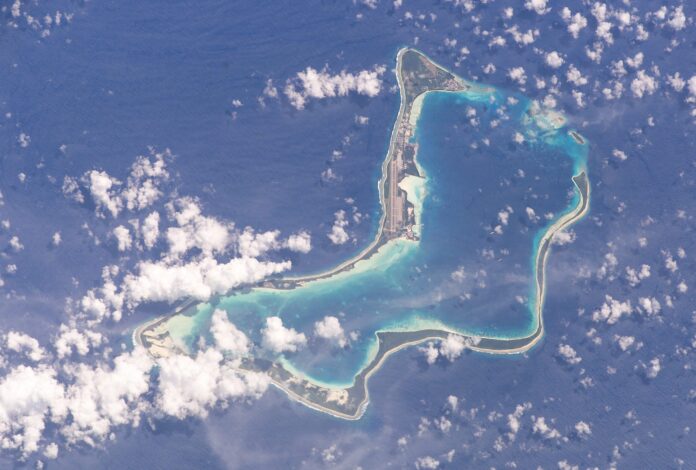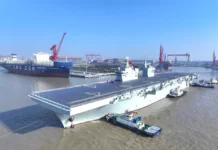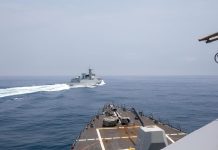
By Nathaniel England*
Australia should formally propose to establish a modest rotational presence on Diego Garcia – a UK administered territory, recently transferred under Mauritius sovereignty.
The island currently hosts a military base leased long-term to the United States, and serves as a major allied strategic naval installation in the middle of the Indian Ocean (Naval Support Facility Diego Garcia). Despite this being a predominantly US establishment, this is officially a joint facility with a permanent UK presence. (From: The Interpreter. The Lowy Institute.)
Sovereignty concerns between the UK, US and Mauritius remain politically sensitive, and although this is not Australia’s dispute, it may require some diplomatic navigation. Either way, the base will remain in operation for the foreseeable future and should not deter the logic of Canberra pursuing participation there.
By joining, Australia would strengthen its ability to safeguard maritime connections while deepening defence ties with its partners, the UK and US. This would effectively transform Diego Garcia into an “AUKUS Island”: a trilateral hub that institutionalises allied cooperation in the Indian Ocean.
Politically, such a move would signal that Canberra is prepared to assume greater allied responsibility – turning AUKUS from a technology partnership into a genuinely shared strategic posture.
An Australian presence could be initially light, using equipment already in service. This might include rotational operations by P-8A Poseidon and other surveillance aircraft, a small logistics element and embedded liaison officers.
While such activities may already occur on an ad-hoc or contingency basis, they sit outside any declared, structured arrangement. Formalising access under AUKUS would legitimise these deployments and ensure routine integration with US and UK operations rather than episodic access. Similarly, Royal Australian Navy ships may already refuel there during extended deployments, but these visits are otherwise occasional or ad-hoc. Formalising it as a continuous port of call offers enhanced logistical planning.
Regularised access must be a mutually recognised element of allied burden-sharing.
It would also demonstrate that Australia can contribute meaningfully to regional stability, not merely as a beneficiary of allied protection but as a proactive partner shaping outcomes in its own region.
Anchoring in the central Indian Ocean also adds strategic depth to northern and western basing by giving another hub from which to sustain operations. From Diego Garcia, Australia could respond more quickly to events in the west and north-west of the Indian Ocean – around the Horn of Africa and Strait of Hormuz. This would turn current limited contributions into future sustained presence during crises.
The logic is simple: low cost, high payoff.
Because the base already exists under allied control, Australia would plug into established infrastructure rather than build its own. Even a small footprint would deliver longer time on station, broader patrol coverage, as well as improved availability and readiness.
Washington and London may not demand an Australian presence, but a contribution at Diego Garcia would be valuable precisely because it is proactive – signalling Australia’s willingness to take regional responsibility.
Diego Garcia offers a uniquely secure and operationally relevant site for Pillar II activities: combining UK presence, existing US infrastructure, and access to the busiest maritime corridors. That makes it an ideal venue for intelligence, surveillance and reconnaissance integration and could enable trials of AI-enabled maritime surveillance, secure cyber/data links, and joint sustainment exercises – potentially turning technology development into operational practice.
In the years ahead, as AUKUS nuclear submarines enter service in the 2030s and 2040s (under Pillar I), Diego Garcia offers the only mature allied hub in the central Indian Ocean capable of forward sustainment. That role would extend patrol endurance and enable long-range strike options across the wider Indian Ocean.
At a time when the Pentagon’s review may delay or reduce the number of US submarines transferred to Australia, a structured presence at Diego Garcia would ensure that Canberra still gains tangible benefit from AUKUS cooperation. It would serve as a visible form of alliance reciprocity – a practical outcome that strengthens integration and deterrence even if the submarine timeline slips.
A forward posture at Diego Garcia also complements the 2023 Defence Strategic Review – which emphasised both deepening alliance integration with the United States, and holding adversaries at risk at further distance from Australia’s shores.
Although China’s military modernisation drives Australia to orient defence policy northwards, incorporating Diego Garcia would reinforce the North-East Indian Ocean, turning northern investments into a truly Indo-Pacific posture that safeguards Australia’s security and prosperity.
These strategic benefits also extend to trade security. An important share of Australia’s imports and high-value cargoes pass through the Suez Canal, and any diversification away from China will increase reliance on these routes. Disruptions in Red Sea traffic since 2023, which forced diversions around the Cape of Good Hope, underscored the vulnerability of maritime corridors. Even when shipping diverts south via the Cape, the south-western Indian Ocean remains critical – and Diego Garcia is well placed to help secure those lanes.
Alliance dynamics also matter. Washington and London may not demand an Australian presence, but a contribution at Diego Garcia would be valuable precisely because it is proactive – signalling Australia’s willingness to take regional responsibility and project political maturity within AUKUS, at a moment when allied reciprocity is being quietly tested.
The United States already enjoys extensive access to bases at Darwin and Tindal, with rotational forces, fuel facilities and long-range bomber deployments. Yet Australia has no reciprocal-level access to allied hubs in the Indo-Pacific. Establishing a presence at Diego Garcia would help address concerns of perceived relationship imbalance.
In an era of great-power competition, leaving the western Indian Ocean outside of long-term defence thinking is untenable; incorporating Diego Garcia into Australia’s network of defence hubs and AUKUS logistics would be a low-cost step up with disproportionate strategic impact – offering a clear opportunity for Australia to lead in AUKUS and Indo-Pacific security.
*Nathaniel England is a doctoral student at the University of Warsaw and lectures on Indo-Pacific geopolitics at Civitas University (Poland). His research focuses on inter-regional security connections between the Euro-Atlantic and Indo-Pacific regions.



